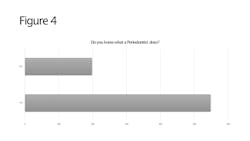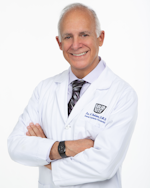The dental specialist: How do we establish brand awareness among our patients?
ACCORDING TO THE American Academy of Periodontology, “A periodontist is a dentist who specializes in the prevention, diagnosis, and treatment of periodontal disease, and in the placement of dental implants. Periodontists are also experts in the treatment of oral inflammation.”
Although many reading this article would think that the various specialties in dentistry, including periodontology, would be well-known, a recently conducted survey proves differently.
Survey results
The survey randomly selected 746 people in the general public across the United States and asked if they knew what a periodontist, an oral surgeon, and an orthodontist did. In addition, participants were asked if they were familiar with a marketing campaign conducted by the American Academy of Periodontology called the “Love the Gums You’re With” campaign.
An equal group of males and females were surveyed (figure 1). Twenty percent of the participants surveyed were over age 60, 35% were under the age of 30, and 45%—the majority—were between the ages of 30 and 60 (figure 2). Around 30% of the participants had a high school education or equivalent degree, 46% had an associate’s or bachelor’s degree, and 20% had a master’s degree, doctorate, or other professional degree (figure 3).
Survey participants were asked about the various specialties in dentistry and if they knew what each specialty did. If participants had general knowledge about the particular dental specialty, they marked “yes”; otherwise, “no.” When asked if they knew what a periodontist does, 74% of the participants said no and 26% said yes (figure 4). When asked if they knew what an oral surgeon does, 41% of the participants said no and 59% said yes (figure 5). When asked if they knew what an orthodontist does, 16% of the participants said no and 84% said yes (figure 6). When asked if they knew of the campaign launched by the American Academy of Periodontology called “Love the Gums You’re With,” 98% of the participants said no and 2% said yes (figure 7).
Marketing the dental specialist
What is the periodontist to do with such a low recognition score? The answer falls into the category of educating the public, but public campaigns have failed to do so thus far. So, where does the answer lie? In our opinion and in our experience, the public not only needs to understand the value of the periodontist, but they will also respond to a periodontist who creates a direct marketing strategy to accomplish that goal.
Who are our patients?
What are the key reasons that the public will respond to a direct-to-public marketing strategy? These are the categories of patients we see simply as a result of an appropriately designed direct-to-patient marketing campaign:
- The frustrated patient—This patient has been disappointed by dentistry, was treated inappropriately (sometimes rudely), and has many dental failures. This patient has often been without dental care for years and now is in such a bad dental state that he or she is looking for the right doctor to help.
- The “bleeding gums” patient—This patient has been treated in the general dentist’s office without success. This patient is perceptive enough to self-refer to a periodontist.
- The “major needs” patient—Much like the frustrated patient, the patient with major dental needs has been given a treatment plan by the general dentist and has decided that if the plan is to be executed, he or she wants the best-qualified doctor to do the work. This patient decides to see a specialist because of the elevated perception that the word specialist connotes.
- The patient looking for the best—Of course, there is always the patient who is looking for the best and wants to see a specialist to take care of his or her dental needs.
The following is opinion, but it is substantiated by practice growth in two distinctly different populations—one in metropolitan New York (SHF) and the other in suburban Florida (LNS). The question that we’ve both attempted to solve is the dichotomy between recognition of the specialty of periodontics and attracting patients directly to our offices for care.
While the term periodontist may not be well recognized, the term specialist is. People are accustomed to seeing specialists for complex needs in medicine; therefore, particularly given the four categories of patients outlined above, there is a potentially large group of patients who have experienced generalist care with less-than-optimal satisfaction. These people are reentering the dental marketplace and looking for something different. As most of these patients have limited, if any, contact with dental specialists, it appears that positioning oneself as an expert—a specialist—would be attractive to a significant portion of that population.
How do we attract patients to our practices?
But we also need to understand what it is about the specialist that attracts the patient. While having a great deal of facility in advanced dental care, the specialist has to know why a patient is seeking his or her care and must validate that concern with the prospective patient. What are those clinical concerns? They can be summarized in four desires: people want to be able to (1) smile, (2) chew, (3) be free of pain, and (4) have sweet-smelling breath. While we, as specialists, may have tools to provide advanced-level care, patients perceive those tools as an adjunct to the four desires listed here.
What other common deficiency have we noted? It is the ability to treatment plan, to think through a case from start to finish. That means looking at the whole case—not just the patient’s immediate need. The ability to treatment plan, give the patient the entire picture, and effectively communicate that plan is a unique and therefore strong differentiator among dental practitioners. Are you able to treatment plan every aspect of a patient’s dental care? Can you plan each case sequentially, presenting a comprehensive step-by-step treatment plan? If so, you are well on your way. If not, that is where you need to start.
You have to be current. You have to have at least some current technology: CT scan; treatment planning software; laser; diagnostic edges such as DNA probes, pH paper; occlusal diagnostic aids such as Shimstock occlusion foil or T-scan; the ability to design and create surgical guides; use of biologic enhancers such as PRF, etc. All of these technologies contribute to positioning your office as a top dental practice in your area.
You must be willing to train your staff to totally support you and be the conduit between you and the patient. Staff training includes the ability to diagnose and treatment plan. This is not just a prevailing thought; it is an absolute. Not only must you have the ability to treatment plan, but you also must teach it to each of your assistants. This will enable your assistant to speak about the proposed treatment more intelligently to the patient. Do not ignore this step; it may be more important than technology.
Some people are natural salespeople. Sales is not a dirty word; it is simply the ability to communicate. Your communications must first be truthful and next, in terms that the patient can understand. Finally, your communication has to be direct, without equivocation. If there are alternative treatment plans, that’s fine. But the one best plan must be communicated to the patient as the best plan, and you must be able to explain why.
Patients are accustomed to seeing specialists for their medical care, yet they don’t know that they can or even need to see a specialist for their dental care unless we tell them that we are here and are available for them. These days, this communication takes place in the form of great websites that direct the patient to call you, advertising campaigns within Google to direct the potential patient to your website, and other unique marketing strategies. As in treatment planning, your practice needs to have a comprehensive marketing strategy. Patients will call you as long as the advertising pertains to them. And after they receive an ad, they are more likely to call if they see lots of great Google reviews about you and your practice. The only way to get such reviews is to ask for them.
Many specialists are willing to discount their fees by 15%–25% or more to be a part of an insurance plan. However, a good marketing strategy only costs about 5% of our annual budgets. There are lots of patients in every community who either do not have dental insurance or do not know the limitations of that insurance, and they will seek an independent periodontist for the four reasons discussed previously.
What happens when the potential patient calls your office? The person answering the phone is your representative in that patient’s eyes. If your phone receptionist is confident, knowledgeable, and can communicate the benefits of seeing you, the prospective patient will make an appointment for an examination. Far too often, though, the receptionist or scheduler is the least trained person in the office. Many do not realize that this team member is responsible for the success of your marketing. If your team member gains the patient’s trust, the patient will schedule the exam with you. If not, the patient will go to the next website looking for another dentist (note we are not saying periodontist).
How can the independent specialist thrive?
So, yes, technology is important. Communication skills are important. The ability to treatment plan is important. The ability to create a great result is important. And staff training and practice systems are important. Assuming you are a great doctor, integrate those five principles into your practice and you will succeed. Then, you can refer your patients to the best restorative dentists, when applicable, and both the patients and restorative dentists will thrive. Those great restorative dentists will, in turn, refer more patients to you.
This is how the independent periodontist can thrive. And there is a bonus. This preparation puts you in a great position to head a group practice when the need or opportunity arrives. After all, that is the direction in which dentistry is moving. Be at the top as an independent periodontist, learn the skills to do so, and you will then create the mechanics to expand your practice into a full-service group practice. This is the optimal plan for many. And it is the perfect plan for the future.
Editor’s note: This article originally appeared in Perio-Implant Advisory, a chairside resource for dentists and dental hygienists for issues relating to periodontal and implant medicine. Exclusive content from an academic perspective centers on complex care, solving clinical complications from a team-based approach through interdisciplinary management.

















